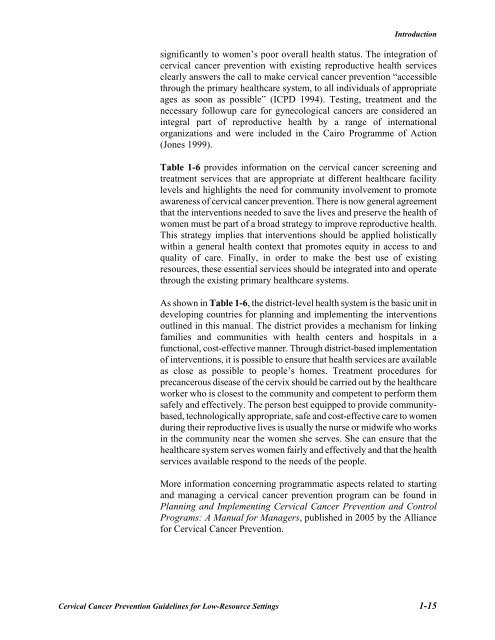Reference Manual - IARC Screening Group
Reference Manual - IARC Screening Group
Reference Manual - IARC Screening Group
You also want an ePaper? Increase the reach of your titles
YUMPU automatically turns print PDFs into web optimized ePapers that Google loves.
Introductionsignificantly to women’s poor overall health status. The integration ofcervical cancer prevention with existing reproductive health servicesclearly answers the call to make cervical cancer prevention “accessiblethrough the primary healthcare system, to all individuals of appropriateages as soon as possible” (ICPD 1994). Testing, treatment and thenecessary followup care for gynecological cancers are considered anintegral part of reproductive health by a range of internationalorganizations and were included in the Cairo Programme of Action(Jones 1999).Table 1-6 provides information on the cervical cancer screening andtreatment services that are appropriate at different healthcare facilitylevels and highlights the need for community involvement to promoteawareness of cervical cancer prevention. There is now general agreementthat the interventions needed to save the lives and preserve the health ofwomen must be part of a broad strategy to improve reproductive health.This strategy implies that interventions should be applied holisticallywithin a general health context that promotes equity in access to andquality of care. Finally, in order to make the best use of existingresources, these essential services should be integrated into and operatethrough the existing primary healthcare systems.As shown in Table 1-6, the district-level health system is the basic unit indeveloping countries for planning and implementing the interventionsoutlined in this manual. The district provides a mechanism for linkingfamilies and communities with health centers and hospitals in afunctional, cost-effective manner. Through district-based implementationof interventions, it is possible to ensure that health services are availableas close as possible to people’s homes. Treatment procedures forprecancerous disease of the cervix should be carried out by the healthcareworker who is closest to the community and competent to perform themsafely and effectively. The person best equipped to provide communitybased,technologically appropriate, safe and cost-effective care to womenduring their reproductive lives is usually the nurse or midwife who worksin the community near the women she serves. She can ensure that thehealthcare system serves women fairly and effectively and that the healthservices available respond to the needs of the people.More information concerning programmatic aspects related to startingand managing a cervical cancer prevention program can be found inPlanning and Implementing Cervical Cancer Prevention and ControlPrograms: A <strong>Manual</strong> for Managers, published in 2005 by the Alliancefor Cervical Cancer Prevention.Cervical Cancer Prevention Guidelines for Low-Resource Settings 1-15
















